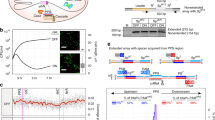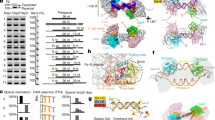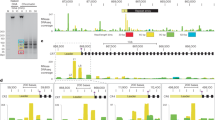Abstract
The adaptation phase of CRISPR–Cas immunity depends on the precise integration of short segments of foreign DNA (spacers) into a specific genomic location within the CRISPR locus by the Cas1–Cas2 integration complex. Although off-target spacer integration outside of canonical CRISPR arrays has been described in vitro, no evidence of non-specific integration activity has been found in vivo. Here, we show that non-canonical off-target integrations can occur within bacterial chromosomes at locations that resemble the native CRISPR locus by characterizing hundreds of off-target integration locations within Escherichia coli. Considering whether such promiscuous Cas1–Cas2 activity could have an evolutionary role through the genesis of neo-CRISPR loci, we combed existing CRISPR databases and available genomes for evidence of off-target integration activity. This search uncovered several putative instances of naturally occurring off-target spacer integration events within the genomes of Yersinia pestis and Sulfolobus islandicus. These results are important in understanding alternative routes to CRISPR array genesis and evolution, as well as in the use of spacer acquisition in technological applications.
This is a preview of subscription content, access via your institution
Access options
Access Nature and 54 other Nature Portfolio journals
Get Nature+, our best-value online-access subscription
$29.99 / 30 days
cancel any time
Subscribe to this journal
Receive 12 digital issues and online access to articles
$119.00 per year
only $9.92 per issue
Buy this article
- Purchase on Springer Link
- Instant access to full article PDF
Prices may be subject to local taxes which are calculated during checkout





Similar content being viewed by others
References
Barrangou, R. et al. CRISPR provides acquired resistance against viruses in prokaryotes. Science 315, 1709–1712 (2007).
Marraffini, L. A. & Sontheimer, E. J. CRISPR interference limits horizontal gene transfer in staphylococci by targeting DNA. Science 322, 1843–1845 (2008).
Wright, A. V., Nuñez, J. K. & Doudna, J. A. Biology and applications of CRISPR systems: harnessing nature’s toolbox for genome engineering. Cell 164, 29–44 (2016).
Sternberg, S. H., Richter, H., Charpentier, E. & Qimron, U. Adaptation in CRISPR–Cas systems. Mol. Cell. 61, 797–808 (2016).
Brouns, S. J. J. et al. Small CRISPR RNAs guide antiviral defense in prokaryotes. Science 321, 960–964 (2008).
Nuñez, J. K., Bai, L., Harrington, L. B., Hinder, T. L. & Doudna, J. A. CRISPR immunological memory requires a host factor for specificity. Mol. Cell. 62, 824–833 (2016).
Yosef, I., Goren, M. G. & Qimron, U. Proteins and DNA elements essential for the CRISPR adaptation process in Escherichia coli. Nucleic Acids Res. 40, 5569–5576 (2012).
Levy, A. et al. CRISPR adaptation biases explain preference for acquisition of foreign DNA. Nature 520, 505–510 (2015).
Nuñez, J. K., Lee, A. S., Engelman, A. & Doudna, J. A. Integrase-mediated spacer acquisition during CRISPR–Cas adaptive immunity. Nature 519, 193–198 (2015).
Nuñez, J. K. et al. Cas1–Cas2 complex formation mediates spacer acquisition during CRISPR–Cas adaptive immunity. Nat. Struct. Mol. Biol. 21, 528–534 (2014).
Wright, A. V. et al. Structures of the CRISPR genome integration complex. Science 357, 1113–1118 (2017).
Savitskaya, E., Semenova, E., Dedkov, V., Metlitskaya, A. & Severinov, K. High-throughput analysis of type I-E CRISPR/Cas spacer acquisition in E. coli. RNA Biol. 10, 716–725 (2013).
Shmakov, S. et al. Pervasive generation of oppositely oriented spacers during CRISPR adaptation. Nucleic Acids Res. 42, 5907–5916 (2014).
Wang, J. et al. Structural and mechanistic basis of PAM-dependent spacer acquisition in CRISPR–Cas systems. Cell 163, 840–853 (2015).
Shipman, S. L., Nivala, J., Macklis, J. D. & Church, G. M. Molecular recordings by directed CRISPR spacer acquisition. Science 353, aaf1175 (2016).
McGinn, J. & Marraffini, L. A. CRISPR–Cas systems optimize their immune response by specifying the site of spacer integration. Mol. Cell. 64, 616–623 (2016).
Wright, A. V. & Doudna, J. A. Protecting genome integrity during CRISPR immune adaptation. Nat. Struct. Mol. Biol. 10, 876–883 (2016).
Wang, R., Ming, L., Gong, L., Hu, S. & Xiang, H. DNA motifs determining the accuracy of repeat duplication during CRISPR adaptation in Haloarcula hispanica. Nucleic Acids Res. 44, 4266–4277 (2016).
Goren, M. G. et al. Repeat size determination by two molecular rulers in the type I-E CRISPR array. Cell. Rep. 16, 2811–2818 (2016).
Rollie, C., Schneider, S., Brinkmann, A. S., Bolt, E. L. & White, M. F. Intrinsic sequence specificity of the Cas1 integrase directs new spacer acquisition. eLife 4, e08716 (2015).
Kunin, V., Sorek, R. & Hugenholtz, P. Evolutionary conservation of sequence and secondary structures in CRISPR repeats. Genome Biol. 8, R61 (2007).
Shipman, S. L., Nivala, J., Macklis, J. D. & Church, G. M. CRISPR–Cas encoding of a digital movie into the genomes of a population of living bacter. Nature 547, 345–349 (2017).
Marraffini, L. A. CRISPR–Cas immunity in prokaryotes. Nature 526, 55–61 (2015).
Datsenko, K. A., Pougach, K., Tikhonov, A., Wanner, B. L., Severinov, K. & Semenova, E. Molecular memory of prior infections activates the CRISPR/Cas adaptive bacterial immunity system. Nat. Commun. 3, 945 (2012).
Kuznedelov, K. et al. Altered stoichiometry Escherichia coli cascade complexes with shortened CRISPR RNA spacers are capable of interference and primed adaptation. Nucleic Acids Res. 44, 10849–10861 (2016).
Grissa, I., Vergnaud, G. & Pourcel, C. The CRISPRdb database and tools to display CRISPRs and to generate dictionaries of spacers and repeats. BMC Bioinforma. 8, 172 (2007).
Barros, M. P. S. et al. Dynamics of CRISPR loci in microevolutionary process of Yersinia pestis strains. PLoS ONE 9, e108353 (2014).
Eppinger, M. et al. Genome sequence of the deep-rooted Yersina pestis strain angola reveals new insights into the evolution and pangenome of the plague bacterium. J. Bacteriol. 192, 1685–1699 (2010).
Jaubert, C. Genomics and genetics of Sulfolobus islandicus LAL14/1, a model hyperthermophilic archaeon. Open. Biol. 3, 130010 (2013).
Gudbergsdottir, S. et al. Dynamic properties of the Sulfolobus CRISPR/Cas and CRISPR/Cmr systems when challenged with vector-borne viral and plasmid genes and protospacers. Mol. Microbiol. 79, 35–49 (2011).
Reno, M. L., Held, N. L., Fields, C. J., Burke, P. V. & Whitaker, R. J. Biogeography of the Sulfolobus islandicus pan-genome. Proc Natl. Acad. Sci. USA 106, 8065–8610 (2009).
Jiang, Y. et al. Multigene editing in Escherichia coli genome via the CRISPR–Cas9 system. Appl. Environ. Microbiol. 81, 2506–2514 (2015).
Acknowledgements
The authors thank Ekaterina Semonova and Konstantin Severinov (Rutgers) for generously providing strain BW40114, and J. Doudna and L. Harrington (UCB) for generously providing BL21-AI IHF-knockout strains. The project was supported by grants from the National Human Genome Research Institute (5R01MH103910), the National Human Genome Research Institute (5RM1HG008525) and the Simons Foundation Autism Research Initiative (368485) to G.M.C.
Author information
Authors and Affiliations
Contributions
J.N. and S.L.S. conceived the study. J.N. designed the work, performed the experiments, analysed the data and wrote the manuscript with input from S.L.S. and G.M.C. S.L.S. and G.M.C. discussed the results and commented on the manuscript.
Corresponding author
Ethics declarations
Competing interests
J.N., S.L.S. and G.M.C. are inventors on a provisional patent (62/490,901) filed by the President and Fellows of Harvard College that covers the work in this manuscript. A complete account of the financial interests of G.M.C. is listed at: http://arep.med.harvard.edu/gmc/tech.html.
Additional information
Publisher’s note: Springer Nature remains neutral with regard to jurisdictional claims in published maps and institutional affiliations.
Supplementary information
Supplementary Information
Supplementary Figures 1–8, Supplementary Tables 1 and 2.
Rights and permissions
About this article
Cite this article
Nivala, J., Shipman, S.L. & Church, G.M. Spontaneous CRISPR loci generation in vivo by non-canonical spacer integration. Nat Microbiol 3, 310–318 (2018). https://doi.org/10.1038/s41564-017-0097-z
Received:
Accepted:
Published:
Issue Date:
DOI: https://doi.org/10.1038/s41564-017-0097-z
This article is cited by
-
Robust direct digital-to-biological data storage in living cells
Nature Chemical Biology (2021)
-
Spacers go off-site
Nature Reviews Microbiology (2018)
-
CRISPRs from scratch
Nature Microbiology (2018)
-
DNA-based memory devices for recording cellular events
Nature Reviews Genetics (2018)



